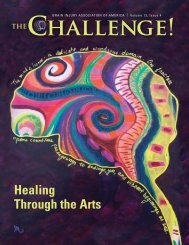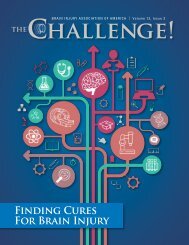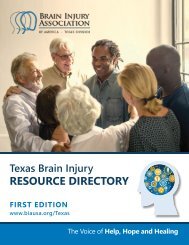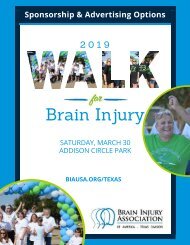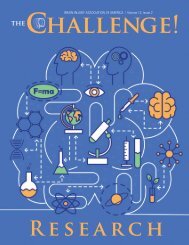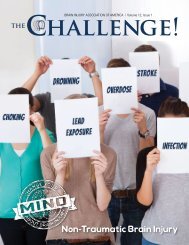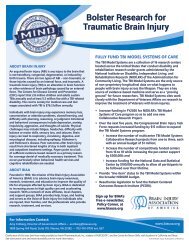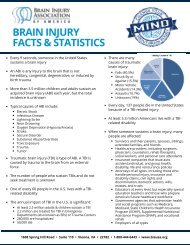THE Challenge! Spring 2011
Communication
Communication
You also want an ePaper? Increase the reach of your titles
YUMPU automatically turns print PDFs into web optimized ePapers that Google loves.
Communication<br />
Strategies<br />
Personal Logs: The use of a personal log can be helpful in tracking progress toward an individual goal, such as increasing<br />
sustained attention for reading or improving the ability to start a conversation. Below are two examples of a personal log.<br />
TOPIC<br />
Person Spoken to<br />
Comment<br />
The Weather<br />
Sports ("Did you see last night’s Eagle’s game?")<br />
Movies or TV ("Have you seen any good movies?")<br />
Current events<br />
Hobbies<br />
Past knowledge of the person<br />
(For example "How was your vacation?")<br />
Compliments<br />
Commenting on something in the area where you are<br />
Work (For example "How is work going?")<br />
Relationships<br />
Before starting the conversation: Think to yourself:<br />
o Is this a good time to start a conversation?<br />
o Repeating a person’s name when you meet them,<br />
may help you remember the name.<br />
o Think about looking at the person you are talking to.<br />
o Think about the impression you want to make:<br />
(friendly, serious, interested in others)<br />
Week of<br />
Monday<br />
Tuesday<br />
Wednesday<br />
Thursday<br />
Friday<br />
Saturday<br />
Sunday<br />
What I Read<br />
Amount of Time<br />
I read/# of pages<br />
Fatigue Level<br />
at End (1-5)<br />
The purpose of this log is to keep track of how long you read each day<br />
before you become tired or can no longer concentrate on what you are<br />
reading.Try to read a little each day.<br />
1 = NOT TIRED 5 = EXHAUSTED<br />
Pay attention to how long you read before you feel yourself becoming<br />
tired. Stop reading when you feel tired and rate the level of your fatigue.<br />
References:<br />
Coehlo, C.A. (December 2002). Story narratives of adults with<br />
closed head injury and non-brain injured adults. Journal of Speech<br />
and Hearing Research. Vol. 45: 1232-1248.<br />
Coehlo, C.A.; Youse, K.M.; Lee, K. E. (2002). Conversational<br />
Discourse in closed-head injured and non-brain-injured adults.<br />
Issue of Cognition. Aphasiology. 16, (4/5/6): 659-672.<br />
Fraas, M.; Balz, M.A. (2008). Expressive Electronic Journal<br />
Writing: Freedom of Communication for Survivors of Acquired<br />
Brain Injury. Journal of Psycholinguistic Research. 37:115-124.<br />
Grice, H.P. (1975). Logic and Conversation in (eds) Cole, P. and<br />
Morgan, J. Studies in Syntax and Semantics III: Speech Acts. New<br />
York Academic Press. 183-198.<br />
Silverman, F.; Miller, L. (2006). Introduction to Communication<br />
Sciences and Disorders, Thinking Publications University.<br />
Ylvisaker, M.; Szekeres, S; Feeney, T. (2001). Communication<br />
Disorders Associated with Traumatic Brain Injury in Chapey R.<br />
(Ed.) Language Intervention Strategies in Aphasia.- 4th Edition.<br />
Lippincott, Williams and Wilkins. 745 – 808.<br />
<strong>THE</strong> <strong>Challenge</strong>! | <strong>Spring</strong> <strong>2011</strong><br />
6







